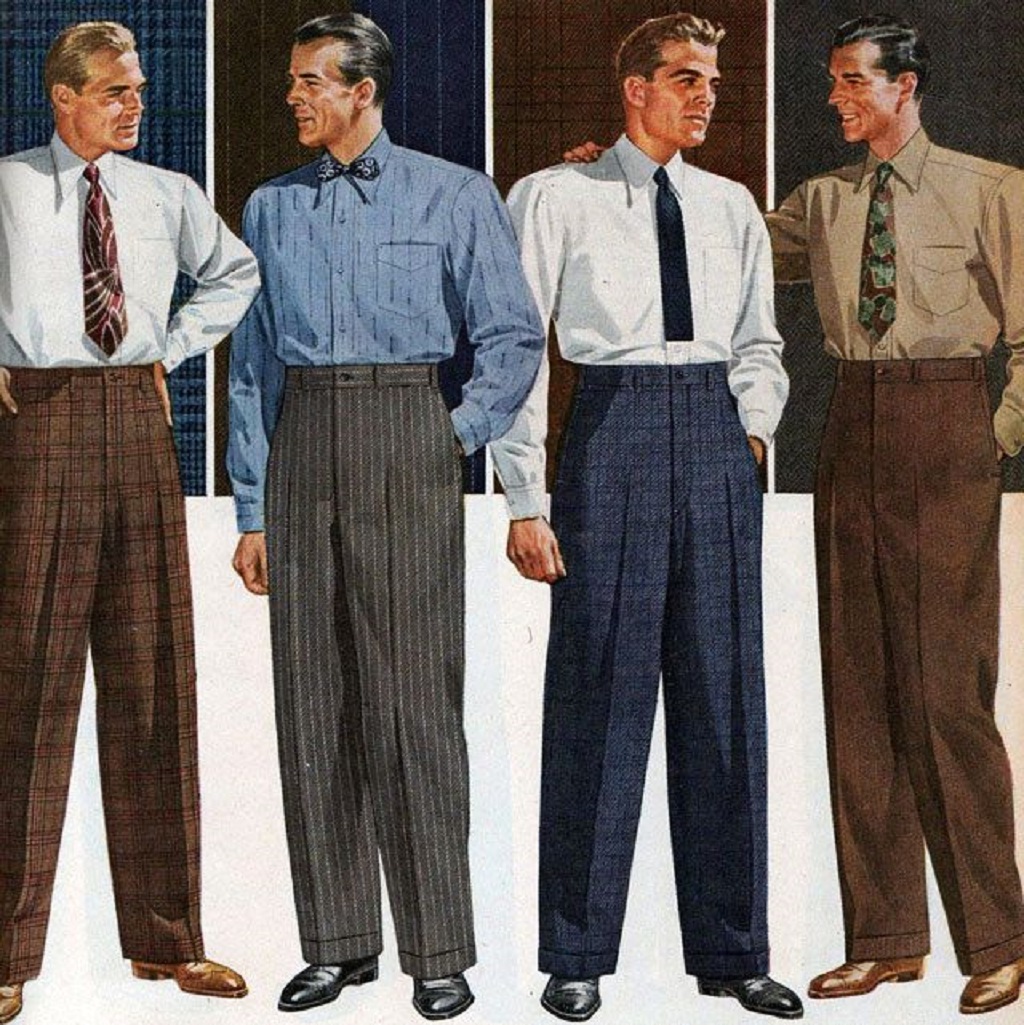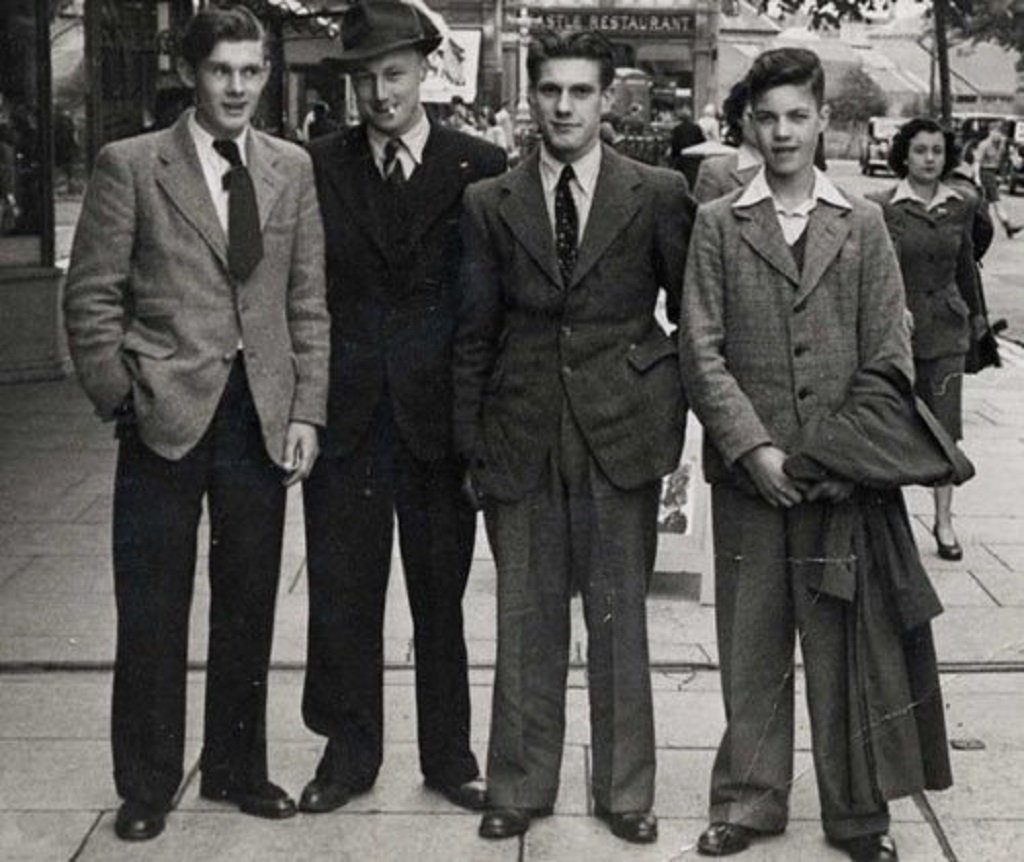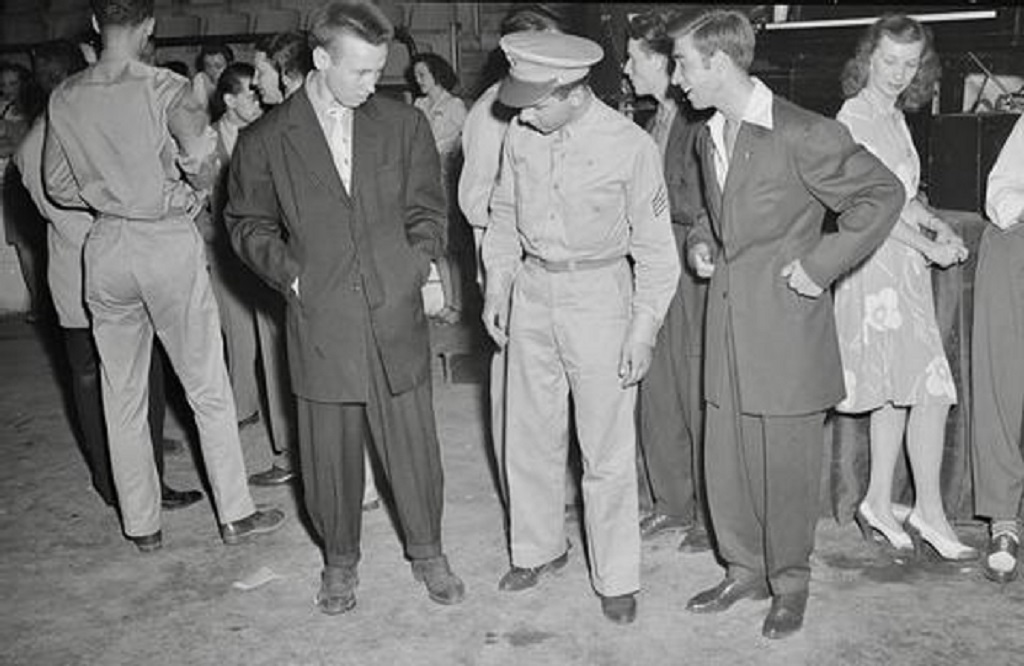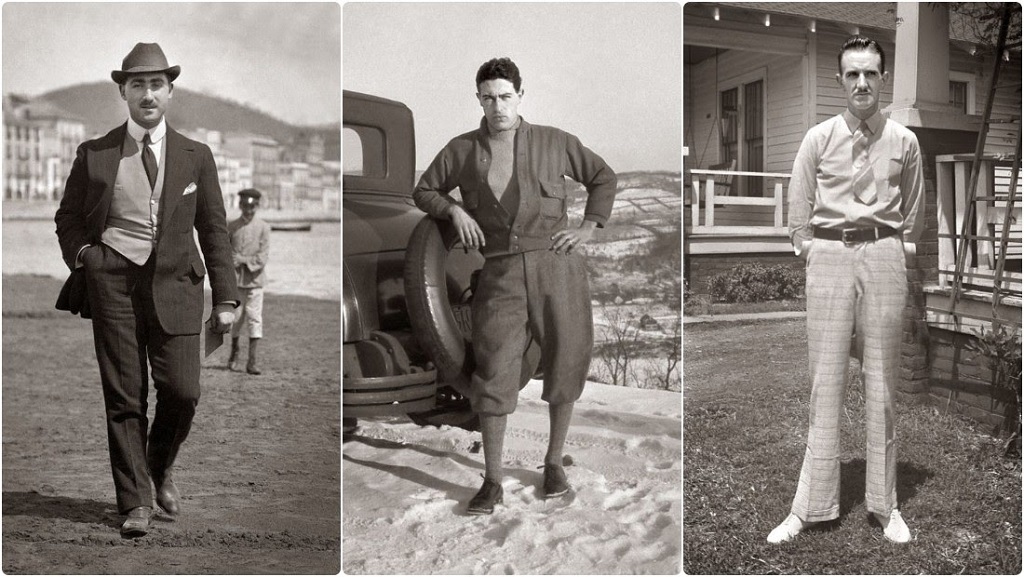
The 1940s was a transformative decade for men’s fashion. World War II significantly influenced clothing trends, with fabric rationing leading to more subdued and utilitarian styles. Despite wartime austerity, men still aimed to look dapper and well-put-together.
Many elements of 1940s style remain stylish today. By understanding the key pieces and how to wear them, any man can incorporate a dash of retro elegance into his modern wardrobe. Read on to learn about the essential aspects of 1940s mens fashion and how to make them work in the 21st century.
The 1940s Mens Fashion Silhouette

The classic 1940s male silhouette had a few defining features:
- Shoulders: Padded, broad shoulders were popular, creating a masculine V-shape. This conveyed strength and confidence.
- Lapels: Jacket and coat lapels were wide to accentuate those strong shoulders.
- Trousers: Pants were high-waisted, cuffed, and often pleated. This differed from the low baggy trousers of the 1930s.
- Tapered cut: While not overly fitted, suits and jackets created a trim and tailored silhouette. This flattered the male figure.
The key to capturing the 1940s shape is to aim for structure. Select jackets with some shoulder padding and trousers that are well-fitted through the hips and thighs. Pleats, cuffs, and a high waistband polish the look. Overall, a put-together neatness encapsulates 1940s style.
The Impact of Rationing
World War II cloth rationing influenced the aesthetic of the decade. To conserve resources for the war effort, the L-85 decree restricted fabric used in clothing production.
Jackets and coats became more sparse in detail. Trousers lost cuffs and pleats. Clothing had fewer decorative elements overall. These restrictions actually created a very clean-lined, minimalist style.
Some aspects of 1940s fashion arose directly from the shortages. Due to a lack of new fabrics, re-purposed clothing gained popularity. Style-conscious men tailored old suits and coats to keep up with changing trends.
Upcycling and simplicity are still chic today. Seek out high-waisted trousers in solid colors or subtle patterns. Look for secondhand jackets and coats and tailor them to a modern fit. Opt for minimal detailing to emulate the rationing-era aesthetic.
Key Wardrobe Basics
While 1940s men’s fashion had less variety than previous decades, some staple items formed the foundation of a well-dressed gentleman’s wardrobe.
Suit Jackets and Ventless Blazers
The sack suit dominated 1940s mens fashion style. This had an unfitted, boxy shape that still created masculine angles.
Most suit jackets were ventless, meaning they lacked the slit in the back bottom. This cleanly streamlined the silhouette. Opt for ventless jackets or solid blazers to get the 1940s look.
Pair suit jackets with high-waisted trousers. Suspenders were also popular to keep pants aligned with jackets.
Ties and Neckties
Even with fabric rationing, a variety of ties and neckties were common in the 1940s. These included:
- Knit ties: Often striped or solid in color, these added texture.
- Bow ties: A classic style, bow ties added personality.
- Neckties: Sometimes more narrow than 1930s wide ties, these came in patterns like polka dots or Art Deco motifs.
Knit and bow ties pair especially well with button-down shirts to channel a 1940s vibe. Add a necktie when wearing a formal suit.
Button-Down Shirts
Button-down shirts grew in popularity during the 1940s. Their classic collars, buttoned to keep in place, were practical and polished.
Light blue and white button-downs remain staples today. Pair them with suits in gray, tan, or brown shades. Roll sleeves up for a relaxed 1940s mens fashion workwear look.
Trousers
High-waisted and cuffed trousers characterize 1940s mens fashion style. Pleats also added shape and movement.
Look for trousers that hit near your natural waist. Suspenders or belted trousers can cinch in the waistband. Consider getting a tailored pair with pleats and cuffs for a fully authentic silhouette.
Wool trousers in gray and tan pair well with button-down shirts and suit jackets.
Hats
Hats were a must for 1940s style. The most popular options included:
- Fedoras: These felt wide-brimmed hats added a touch of elegance.
- Newsboy caps: Also known as the gatsby, these flat-topped hats had a sporty vibe.
- Trilby hats: The trilby had a short brim and indented crown. This was a dressier alternative to the wider fedora brim.
For modern looks, try a felt fedora or tweed newsboy cap. Tilting the brim down slightly gives a mysterious edge mens fashion.
Use these tips to create cohesive 1940s-inspired outfits:
- Stick to a neutral color palette. Gray, tan, brown, navy, and forest green were popular suit hues.
- Combine patterns carefully. Small checks and plaids pair nicely with subtle pinstripes or polka dot neckties.
- Add vintage accessories. Suspenders, leather shoes or boots, and a hat complete the retro look.
- Show your socks. Mid-calf patterned socks in argyle or Art Deco motifs peeking out from trousers add flair.
- Try a watch chain. Connecting from a vest button to a pocket watch, these accessories reflect the decade’s masculine elegance.
Dressing in 1940s mens fashion style is about honoring the era’s poised sensibility. Tailored pieces, tasteful patterns, and smart accessories communicate timeless confidence and class.
1940s Fashion Elements to Avoid
While many 1940s trends easily work today, some elements deserve a place in history books rather than the average modern man’s closet. Avoid these overly dated aspects:
Bold Shoulder Pads
The 1980s took the 1940s shoulder trend to extremes. Keep padding subtle for a flattering silhouette. Extremely broad shoulders appear costumey.
High-Waisted Trousers With Exposed Socks
Classic high-waisted pants deserve a comeback. However, wearing them hiked up to expose several inches of socks looks more clownish than retro. Keep sock exposure minimal.
Exaggerated Fedoras
Trilby and short-brimmed fedora styles translate charmingly to today’s wear. But those ’40s movie-star giant brims appear over-the-top now. Seek out tasteful hat proportions.
Loud Novelty Ties
While knit and patterned ties work in moderation, overstated novelty ties were also a 1940s trend. Unless you’re a circus ringmaster, leave clown ties back in the past.
Costumey Suiting
Dapper 1940s suits with subtle pinstripes or windowpane checks hit the style bullseye. But past patterned suits with bold plaids or giant houndstooth appear more costumey than stylish now.
How to Incorporate Key 1940s Pieces Into Modern Outfits

Many signature 1940s men’s fashion pieces seamlessly transition to the present day. Here are ideas for integrating them into modern looks:
Pleated Trousers
While mainstream menswear gravitated toward flat-front pants in the 2000s, pleated trousers are back in vogue. Wear them with a tucked-in button-down shirt for a retro-inspired business casual aesthetic. Tradesman or workwear shirts also pair nicely.
Cuff pleated trousers a quarter or half inch to show off some ankle and pay homage to the decade. Suspenders add extra flair but aren’t essential.
Knit Ties
A knit tie might seem like a bold choice compared to the standard necktie. But this textured accessory adds interest and approachability to a dress shirt and blazer.
Pair knit ties with checked or striped shirts to coordinate patterns. Keep the shirt and blazer simple to let the tie stand out.
For casual wear, don knit ties with cardigans, crew neck sweatshirts, or collared shirts. This elevates laid-back outfits beyond basic tees.
Bow Ties
While the bow tie fell out of everyday use after the 1940s, it remains a go-to formalwear accessory. The key is balancing the bow tie’s personality with refined complementary pieces.
Stick to klassic black, white, or muted color bow ties to avoid looking clownish. Pair with a nicely cut suit jacket. A pocket square adds polish without overdoing it.
For whimsical flair at informal events, experiment with patterns like polka dots and plaids. Just maintain scale and coordination with other outfit elements.
Suspenders
Also called braces, suspenders disappear beneath jackets to discretely keep trousers aligned at the waist. Clip them to high-waisted pants, preferably with pleats and cuffs.
Stick to leather, fabric, or subtle patterned suspenders. Leave wildly printed suspenders to 1980s-themed parties.
Suspenders only enhance high-rise trousers. Donning them with modern low-slung jeans pushes style limits.
Watch Chains
A watch chain spanning from a trouser belt loop or vest button to a pocket watch continues to lend a refined accent. But forgo the pocket watch itself in favor of a more modern wristwatch.
Opt for silver, steel, or leather watch chains. Gold appears overly flashy today. Anchor the chain to a belt loop over dark denim instead of a vest for casual flair.
Just keep the chain proportionate. Overly bulky chains risk skewing costumey. Stick to dainty as an elegant touch.
5 Tips for Thrifting Authentic 1940s Finds
For affordable vintage fashion, thrift stores can yield one-of-a-kind 1940s gems. Here are five tips for thrifting success:
- Seek out suits and jackets first. Tailored blazers, odd jacket-only suit pieces, and overcoats are easier to find than full matching suits. Feel lapels and shoulder pads for proper 1940s shape and texture.
- Inspect construction and markings. Well-constructed pieces with quality lining fabrics signal desirable vintage items. Maker’s marks inside older garments indicate closer to 1940s origins.
- Try the trousers. High waistbands with buttons for suspenders are ideal. Pleats and cuffs complete the vintage look, but these details can be added to plainer trousers by a tailor.
- Feel out fabric content. Mid-weight wools in herringbone, tweed, and pinstripe patterns emulate the decade’s suits. Check fabric content tags or burn tests to identify wool, linen, rayon, and other period-appropriate materials.
- Examine accessories. Suspenders, knit ties, and vintage-styled hats make perfect complementary additions to thrifted wardrobe staples. Look for these items while browsing.
With clever sourcing, secondhand shopping can stock a wardrobe with nattily nostalgic 1940s flair.
FAQs
What did men actually wear in the 1940s?
- Tailored suits with padded shoulders and narrow lapels
- High-waisted pleated trousers
- Button-down shirts and knit or patterned ties
- Fedoras and wide-brimmed hats
- Suspenders
- Cuffed trousers
- Tweed jackets for casualwear
What colors were popular for 1940s menswear?
- Neutral and earthy tones like brown, tan, light gray, navy, and olive
- Some pastels like powder blue
- Tweed jackets featured gray, brown, and green multicolor flecks
- Neckties and suspenders provided bolder pops of color
Did most men wear hats in the 1940s?
Yes, hats were extremely common as part of everyday outfits. Popular styles included wide-brimmed fedoras, short-brimmed trilby hats, tweed newsboy caps, and panama hats in the summer. Hats signaled a well-dressed gentleman.
What did men wear to work in the 1940s?
Many office and white-collar jobs required suits paired with button-down shirts, patterned ties, and fedora hats. Suspenders kept trousers aligned. Blue-collar workers wore more casual pieces like work shirts and trousers with a newsboy cap.
What did men wear to formal events in the 1940s?
A well-tailored dark wool suit was standard formalwear. This was paired with a white button-down shirt, silk necktie, leather shoes, and fedora hat. Tuxedos were reserved for the most formal white-tie affairs. Topcoats or overcoats were worn over suits when necessary.
Conclusion
The 1940s produced many lasting men’s fashion icons. Despite wartime fabric rationing, dapper style prevailed through impeccable tailoring, timeless accessories, and versatile separates.
Integrating signature 1940s mens fashion pieces into modern wardrobes is seamless. Vintage-inspired suits, pleated trousers, bow ties, and watch chains feel fresh and stylish today. Just avoid over-the-top throwback pieces for a tasteful nod to the era. With clever sourcing and styling, the 1940s’ dashing ambiance lives on. Exploring various clothing styles for guys reveals a diverse spectrum of fashion choices, where a man can still distill sophistication and confidence from this transitional decade of menswear. So break out those button-downs, polished oxfords, and refined hats. The spirits of Sinatra, Grant, and Bogart welcome you to embody 1940s panache.

